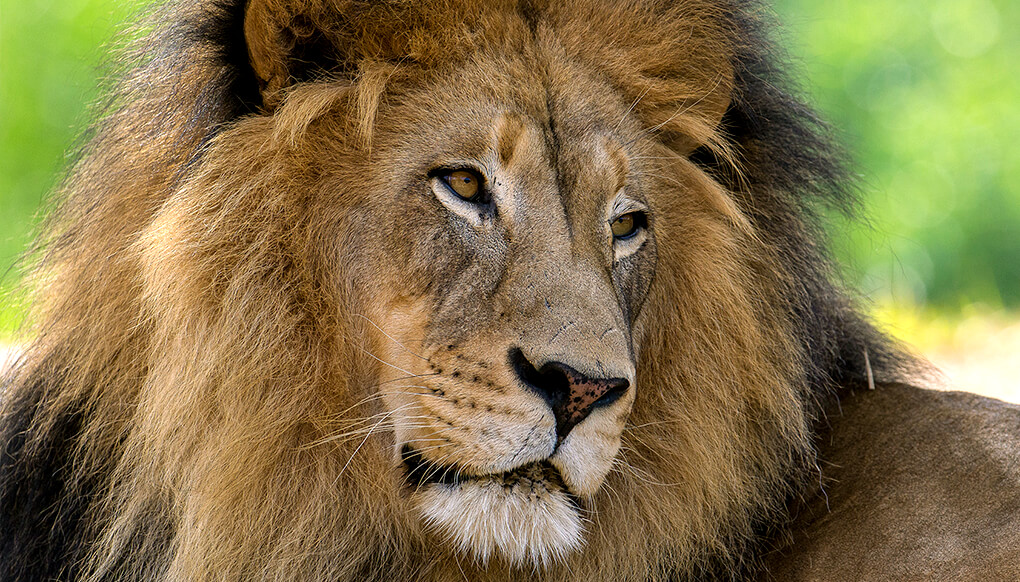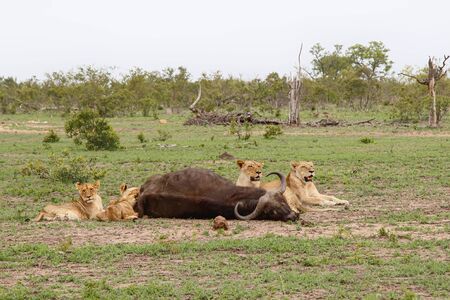




Habits:
Lions are the largest predators in Africa. They are also the most sociable of the cat family and can live in prides of up to 20 and more. Males are territorial and will defend their pride and territory against intruders – some fights could end in death. There are usually between 1 and 4 adult males (a dominant male and other adults or often brothers of the same litter) per pride depending on the size of the territory and the size of their pride which consist of females and their cubs as well as young males.
Males of about two and a half years and older are driven out of the pride and also out of the pride territory by the territorial dominant adult lions. When the territorial dominant adult male lion or lions die or lose a fight and a new male or males take over – young cubs will usually be killed by the new territorial male or males in order to father their own offspring. Females do most of the hunting although males also hunt at times. The pride usually hunt together. At any kill of a pride the dominant male will feed first following other males and then the females. The cubs will feed last when the others had their fill. Lions hunt by stealth. They stalk their prey or wait in ambush near water until the prey animal is close enough to pounce upon. Lions will also kill any predator if they get a chance and often kill the young of leopard, jackal, hyena, cheetah, honey badger, caracal, wild dog and civet amongst others, to naturally eliminate competition for food and territory.
Diet / Food and water:
Lions are opportunistic hunters. They will eat anything from termites to an elephant if they can. Depending on their territory and the species of prey available in the area they usually hunt medium to large size animals like wildebeest, impala, zebra, waterbuck, kudu, buffalo and giraffe amongst others and even in some cases hippos, young rhinos and elephants. Giraffe have been known to inflict serious injuries to lions and often kill lions, while defending themselves by kicking at the lions, especially with their hind legs. Lions are often found following large or smaller herds of buffalo while waiting for a chance to catch and kill one, although buffaloes are not that easy to catch due to the fact that they will not always run away but will group together (often forming a circle around the young) and try to stand their ground in an effort to defend their young and each other. Lions are also often injured or killed by buffaloes, especially by the bulls which can cause a lot of damage with their horns as well as by stomping on the lions with their hard hooves.
Enemies:
Adult lions do not have many natural enemies except in some cases Hyenas (especially a pack / pride of hyenas at a carcass) and humans. However due to the fierce natural competition for food and territory, Leopard, Hyena, African Wild Dog, Cheetah and Jackal will kill lion cubs when the opportunity rises. Pythons, Crocodile and especially humans can also be enemies of Lions and their cubs.
Interesting Facts:
Although lions are not the largest, nor the most powerful of all animals, male lions are often referred to as the King of the Jungle due to their regal posture. Also one of the big 5 animals, a term coined by hunters of old because of the degree of danger involved in hunting lions. There are many reports, since centuries ago, of hunters being injured or killed through the years while trying to hunt lions.
A Male lion’s roars can be heard on a quiet night over 6 km. Lions often roar after a kill or when members of a pride are trying to locate each other. Lionesses have a soft short roar that they utter when calling their cubs. Extreme colour variations and genes in some lions have caused a small number of lions to be born completely white. The most famous of these lions were captured around the Timbavati area in and around the Kruger National Park. There are still a few breeding stations that are trying to breed with white lions.
Reproduction:
Lions mate repeatedly (some say every 15 minutes) over a period of 2 to 3 days.
Gestation period:
110 days. 1 to 6 cubs are born and they can remain with their mothers up to 2 years.
Day or night:
Lions are mainly active during night time although they do sometimes hunt by day should an opportunity presents itself.
Mass:
Male: 170 to 235 kg
Female: 130 to 200 kg
Lifespan:
On Average Lions live
about 15 years.
Status:
around 10,000 in captivity.
Resources:https://www.wildlifesouthafrica.com/blog/mammals-of-south-africa/lion-fact-file#:~:text=Lions%20used%20to%20occur%20throughout,Eastern%20parts%20of%20South%20Africa.
